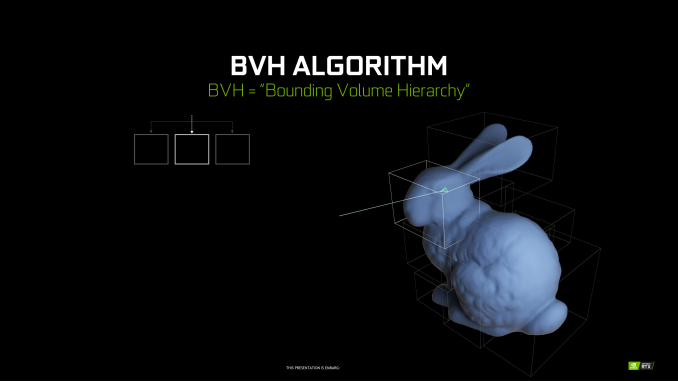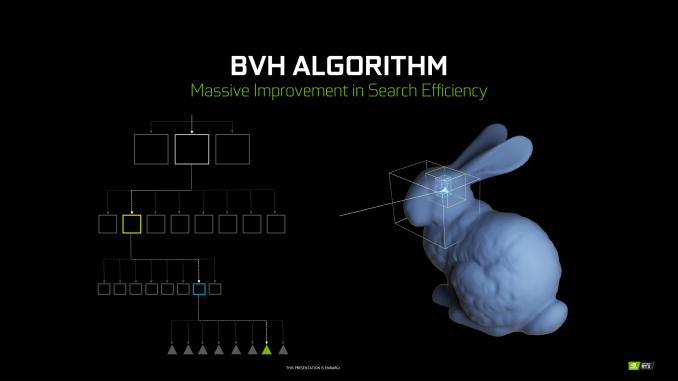The NVIDIA Turing GPU Architecture Deep Dive: Prelude to GeForce RTX
by Nate Oh on September 14, 2018 12:30 PM ESTBounding Volume Hierarchy - How Computers Test the World
Perhaps the biggest aspect of NVIDIA’s gamble on ray tracing is that traditional GPUs just aren’t very good at the task. They’re fast at rasterization and they’re even fast at parallel computing, however ray tracing does not map very well to either of those computing paradigms. Instead NVIDIA has to add hardware dedicated to ray tracing, which means devoting die space and power to hardware that cannot help with traditional rasterization.
A big part of that hardware, in turn, will go into solving the most basic problem of ray tracing: how do you figure out what a ray is intersecting with? The most common solution to this problem is to store triangles in a data structure that is well-suited for ray tracing. And this data structure is called a Bounding Volume Hierarchy.
Conceptually, a BVH is relatively simple – at least for the purposes of this article. Rather than testing every polygon to see if a ray interacts with it, the idea is to test a portion of a scene to see if it interacts with a ray, and then keep drilling down. If there is an intersection with that portion of the scene, then subdivide it into smaller portions and test again. And again. And again. All the way until you reach the individual polygon, at which point the ray testing is resolved.
For the computer scientists in the crowd, this might sound a lot like an application of a binary search, and it is. Each test allows for a significant number of options (in this case polygons) to be discarded as possible answers. This gets to the right polygon in just a fraction of the time. A BVH, in turn, is stored in what’s essentially a tree data structure, with each subdivision – called bounding boxes – stored as children of their parent bounding box.
Now the catch with BVH is that while it radically cuts down on the amount of ray intersection needed compared to a naïve implementation, it’s still not super cheap. A number of tests are still required for each ray, with both successful and failed tests adding to the total number of tests taken. And all of this is for a single ray, when a significant number of rays are going to be needed for each pixel. Which is why hardware acceleration of the process is so important (and not at all easy).
The other major computational cost here is that BVHs themselves aren’t free. One needs to be created for a scene from the polygons in it, so there is an additional step before ray casting can even begin. This is more a developer concern – when can they modify and reuse a BVH versus building a new one – but it’s another step in the process. Furthermore it’s an example of why developer training and efficient engine implementations are so crucial to the process, as a poor implementation can make ray tracing much too slow to be viable.













111 Comments
View All Comments
bernstein - Friday, September 14, 2018 - link
a lot of this will also depend on what kind of silicon ends up in the next playstation & xbox generation...Spunjji - Monday, September 17, 2018 - link
Isn't that already pretty much pinned to AMD? AFAIK Navi is pretty much the consumer interpretation of AMD's PS5 design. Microsoft really aren't likely to jump ship because of their history with Nvidia.Yojimbo - Saturday, September 15, 2018 - link
I think Turing's price/perf ratio will be better than Pascal's. It's the increase in price/performance that is not spectacular. But since AMD isn't releasing anything at all, that doesn't reflect negatively on Turing in any way.I don't know why people are throwing around this "50% of transistors" idea. Where is this information coming from?
Of course Turing will be crushed by a next generation of 7 nm GPUs that is architected equally as well, as such GPUs will have both additional time for architectural improvements and the advantage of a full node shrink. That will be true for both hybrid and raster-only rendering. And it would have been true for raster rendering no matter if RT cores were included or not.
It sounds like NVIDIA is providing the DLSS service to developers for free. I'd expect DLSS usage to be widespread for any developers interested in making games geared towards the 4K market.
I am guessing that Microsoft, at least, will want a raytracing-capable GPU in its next console. I doubt they would spend the effort to make the DXR API extension and then leave the technology out of their console, especially considering the convergence of console and PC gaming they seem to be pushing for.
jwcalla - Friday, September 14, 2018 - link
This is probably my first disinterested nvidia launch. Tensor cores and ray tracing don't really get me excited. I can't imagine half a die used for that stuff. Do the graphics really look that much better? Does hyper-realism even matter?Dizoja86 - Friday, September 14, 2018 - link
It doesn't even have to be hyper-realism. Just the basic limitations you can see with rasterized reflections in the Battlefield V tech demo paints a strong case for the use of ray-tracing. Being able to see reflections of objects that aren't directly on the screen in front of you seems like an important thing to move towards.HollyDOL - Saturday, September 15, 2018 - link
classic rasterized shading and reflection is basically one big cheat on human eye. Imagine something along mp3 128kbit being 'cd quality'. Trying to get that cheat closer and closer to 'reality' is more and more a challenge and resource eater. Ray-Tracing _should_ be able to quite simplify the issue on development front in future. And that's not considering possible visuals quality raise.Tamz_msc - Saturday, September 15, 2018 - link
Lol, players are complaining that in BF V it is hard to distinguish between friendlies and enemies. Adding RTX reflections to the mix would just make it worse.jwcalla - Saturday, September 15, 2018 - link
Watching the Battlefield tech demo (and the others), I didn't think it added a lot of value. When you analyze it side-by-side with a magnifying glass, yes, you can see some differences. I just don't think they're that dramatic and in the heat of game play you're not even going to recognize it. The improvements to global illumination look good though.I just feel like the industry has lost a lot of focus.
RSAUser - Saturday, September 15, 2018 - link
In a game like BF V, you're not just going to stand there looking at reflections, and it's going to hammer your frame rate/force you to go to 1080p or lower.I'd rather turn it off and have a high fps on 4k, tyvm, same as near everyone turned off hairworks for witcher 3, though with that it was at least single player so you'd sacrifice performance for visuals.
Dizoja86 - Friday, September 14, 2018 - link
Sometimes I get frustrated with Anandtech, but being able to have these fantastic articles when new technology is released is why I keep coming back.